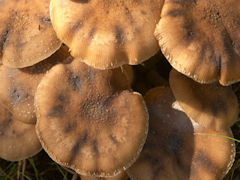Features
Harnessing Molds to Make Valuable Products
Date: 2017-03-23 11:22:23.0
Author: Environmental Molecular Sciences Laboratory
 USA – Molds produce a wide range of both valuable and toxic molecules, which have important implications for energy production, agriculture and human health. A recent study revealed that an organelle within fungal cells called the endoplasmic reticulum acts as a cellular factory for synthesizing diverse natural products called sesquiterpenes in fungal cells.
USA – Molds produce a wide range of both valuable and toxic molecules, which have important implications for energy production, agriculture and human health. A recent study revealed that an organelle within fungal cells called the endoplasmic reticulum acts as a cellular factory for synthesizing diverse natural products called sesquiterpenes in fungal cells.
While some sesquiterpenes are toxins that contaminate cultivated grains and pose a health risk to humans, others are potential precursors to alternative fuels. Understanding how molds make these molecules is essential for engineering fungal cells to produce valuable products instead of harmful toxins.
Filamentous fungi, commonly known as molds, produce a remarkable diversity of natural molecules with unique properties. Many of those properties (byproducts) have been used as pharmaceuticals and antibiotics, and some may be promising alternatives to fossil fuels. But other byproducts are toxins that can contaminate the world's food supply. Despite the importance of these molecules in medicine and agriculture, it has not been clear which cellular compartments are involved in synthesizing natural products in fungal cells.
To address this question, researchers from the University of Minnesota; USDA ARS Cereal Disease Laboratory; EMSL, the Environmental Molecular Sciences Laboratory; Pacific Northwest National Laboratory; and Oregon State University combined microscopy with proteomics to investigate how toxic molecules called sesquiterpenes are formed in the plant-infecting fungus Fusarium graminearum. To do so, they used an Influx flow cytometer/cell sorter and an Orbitrap mass spectrometer at EMSL, a DOE Office of Science user facility. The results revealed that a cellular compartment called the endoplasmic reticulum (ER) serves as a cellular factory for producing specific sesquiterpene molecules. The ER acts as a central staging area to gather raw materials for sesquiterpene synthesis as well as an assembly line coordinating multiple steps of the biosynthetic reaction pathway to streamline the efficiency of sesquiterpene synthesis.
These findings could have important implications for energy production, agriculture and human health. Some scientists have proposed a sesquiterpene called bisabolene could be a precursor for a viable alternative to biodiesel fuels. On the other hand, fungi use the same molecular pathway to produce a compound known as vomitoxin, which contaminates grains such as wheat and barley and poses a health risk to humans. By understanding how these molecules are synthesized in fungal cells, it may be possible to engineer this biochemical pathway to generate valuable products instead of undesirable toxins.
About Environmental Molecular Sciences Laboratory
EMSL’s mission as a national scientific user facility is to lead molecular-level discoveries for the Department of Energy and its Office of Biological and Environmental Research that translate to predictive understanding and accelerated solutions for national energy and environmental challenges.
For further information about EMSL, please visit the website here.
Displaying 4 keywords used to tag this article:
- patents
- Replica Omega Seamaster 231.10.42.2
- enzymes
- carbon capture
